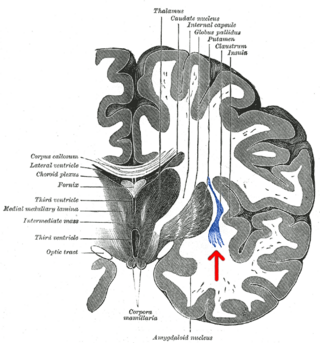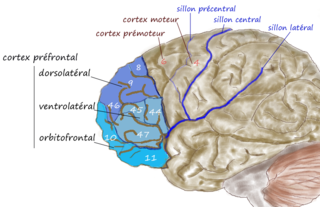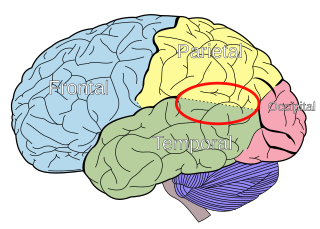Related Research Articles
Psychosis is a condition of the mind that results in difficulties determining what is real and what is not real. Symptoms may include delusions and hallucinations, among other features. Additional symptoms are incoherent speech and behavior that is inappropriate for a given situation. There may also be sleep problems, social withdrawal, lack of motivation, and difficulties carrying out daily activities. Psychosis can have serious adverse outcomes.

The visual cortex of the brain is the area of the cerebral cortex that processes visual information. It is located in the occipital lobe. Sensory input originating from the eyes travels through the lateral geniculate nucleus in the thalamus and then reaches the visual cortex. The area of the visual cortex that receives the sensory input from the lateral geniculate nucleus is the primary visual cortex, also known as visual area 1 (V1), Brodmann area 17, or the striate cortex. The extrastriate areas consist of visual areas 2, 3, 4, and 5.
Working memory is a cognitive system with a limited capacity that can hold information temporarily. It is important for reasoning and the guidance of decision-making and behavior. Working memory is often used synonymously with short-term memory, but some theorists consider the two forms of memory distinct, assuming that working memory allows for the manipulation of stored information, whereas short-term memory only refers to the short-term storage of information. Working memory is a theoretical concept central to cognitive psychology, neuropsychology, and neuroscience.

The parietal lobe is one of the four major lobes of the cerebral cortex in the brain of mammals. The parietal lobe is positioned above the temporal lobe and behind the frontal lobe and central sulcus.

The temporal lobe is one of the four major lobes of the cerebral cortex in the brain of mammals. The temporal lobe is located beneath the lateral fissure on both cerebral hemispheres of the mammalian brain.

The claustrum is a thin sheet of neurons and supporting glial cells, that connects to the cerebral cortex and subcortical regions including the amygdala, hippocampus and thalamus of the brain. It is located between the insular cortex laterally and the putamen medially, encased by the extreme and external capsules respectively. Blood to the claustrum is supplied by the middle cerebral artery. It is considered to be the most densely connected structure in the brain, and thus hypothesized to allow for the integration of various cortical inputs such as vision, sound and touch, into one experience. Other hypotheses suggest that the claustrum plays a role in salience processing, to direct attention towards the most behaviorally relevant stimuli amongst the background noise. The claustrum is difficult to study given the limited number of individuals with claustral lesions and the poor resolution of neuroimaging.
In the philosophy of mind, neuroscience, and cognitive science, a mental image is an experience that, on most occasions, significantly resembles the experience of "perceiving" some object, event, or scene but occurs when the relevant object, event, or scene is not actually present to the senses. There are sometimes episodes, particularly on falling asleep and waking up, when the mental imagery may be dynamic, phantasmagoric, and involuntary in character, repeatedly presenting identifiable objects or actions, spilling over from waking events, or defying perception, presenting a kaleidoscopic field, in which no distinct object can be discerned. Mental imagery can sometimes produce the same effects as would be produced by the behavior or experience imagined.
Magnocellular cells, also called M-cells, are neurons located within the magnocellular layer of the lateral geniculate nucleus of the thalamus. The cells are part of the visual system. They are termed "magnocellular" since they are characterized by their relatively large size compared to parvocellular cells.
Auditory imagery is a form of mental imagery that is used to organize and analyze sounds when there is no external auditory stimulus present. This form of imagery is broken up into a couple of auditory modalities such as verbal imagery or musical imagery. This modality of mental imagery differs from other sensory images such as motor imagery or visual imagery. The vividness and detail of auditory imagery can vary from person to person depending on their background and condition of their brain. Through all of the research developed to understand auditory imagery behavioral neuroscientists have found that the auditory images developed in subjects' minds are generated in real time and consist of fairly precise information about quantifiable auditory properties as well as melodic and harmonic relationships. These studies have been able to recently gain confirmation and recognition due to the arrival of Positron emission tomography and fMRI scans that can confirm a physiological and psychological correlation.
Salience is that property by which some thing stands out. Salient events are an attentional mechanism by which organisms learn and survive; those organisms can focus their limited perceptual and cognitive resources on the pertinent subset of the sensory data available to them.

The posterior cingulate cortex (PCC) is the caudal part of the cingulate cortex, located posterior to the anterior cingulate cortex. This is the upper part of the "limbic lobe". The cingulate cortex is made up of an area around the midline of the brain. Surrounding areas include the retrosplenial cortex and the precuneus.
The Vividness of Visual Imagery Questionnaire (VVIQ) was developed in 1973 by the British psychologist David Marks. The VVIQ consists of 16 items in four groups of 4 items in which the participant is invited to consider the mental image formed in thinking about specific scenes and situations. The vividness of the image is rated along a 5-point scale. The questionnaire has been widely used as a measure of individual differences in vividness of visual imagery. The large body of evidence confirms that the VVIQ is a valid and reliable psychometric measure of visual image vividness.

The dorsolateral prefrontal cortex is an area in the prefrontal cortex of the primate brain. It is one of the most recently derived parts of the human brain. It undergoes a prolonged period of maturation which lasts into adulthood. The DLPFC is not an anatomical structure, but rather a functional one. It lies in the middle frontal gyrus of humans. In macaque monkeys, it is around the principal sulcus. Other sources consider that DLPFC is attributed anatomically to BA 9 and 46 and BA 8, 9 and 10.

The temporoparietal junction (TPJ) is an area of the brain where the temporal and parietal lobes meet, at the posterior end of the lateral sulcus. The TPJ incorporates information from the thalamus and the limbic system as well as from the visual, auditory, and somatosensory systems. The TPJ also integrates information from both the external environment as well as from within the body. The TPJ is responsible for collecting all of this information and then processing it.

Earl Keith Miller is a cognitive neuroscientist whose research focuses on neural mechanisms of cognitive, or executive, control. Earl K. Miller is the Picower Professor of Neuroscience with the Picower Institute for Learning and Memory and the Department of Brain and Cognitive Sciences at Massachusetts Institute of Technology. He is the Chief Scientist and co-founder of SplitSage.
Exceptional memory is the ability to have accurate and detailed recall in a variety of ways, including hyperthymesia, eidetic memory, synesthesia, and emotional memory. Exceptional memory is also prevalent in those with savant syndrome and mnemonists.
Autobiographical memory (AM) is a memory system consisting of episodes recollected from an individual's life, based on a combination of episodic and semantic memory. It is thus a type of explicit memory.
The neuroanatomy of memory encompasses a wide variety of anatomical structures in the brain.
The neuroscience of music is the scientific study of brain-based mechanisms involved in the cognitive processes underlying music. These behaviours include music listening, performing, composing, reading, writing, and ancillary activities. It also is increasingly concerned with the brain basis for musical aesthetics and musical emotion. Scientists working in this field may have training in cognitive neuroscience, neurology, neuroanatomy, psychology, music theory, computer science, and other relevant fields.
Aphantasia is the inability to create mental imagery.
References
- ↑ Cossins D (5 June 2019). "How people with extreme imagination are helping explain consciousness". New Scientist. Retrieved 2021-03-10.
- 1 2 3 4 Zeman A, Milton F, Della Sala S, Dewar M, Frayling T, Gaddum J, et al. (September 2020). "Phantasia–The psychological significance of lifelong visual imagery vividness extremes". Cortex; A Journal Devoted to the Study of the Nervous System and Behavior. 130: 426–440. doi:10.1016/j.cortex.2020.04.003. hdl: 20.500.11820/1ff69a7f-ca92-4745-8165-26f8ca62d6d4 . PMID 32446532. S2CID 218486387.
- ↑ Keogh, Rebecca; Pearson, Joel; Zeman, Adam (2021), "Aphantasia: The science of visual imagery extremes", Neurology of Vision and Visual Disorders, Handbook of Clinical Neurology, vol. 178, Elsevier, pp. 277–296, doi:10.1016/b978-0-12-821377-3.00012-x, ISBN 978-0-12-821377-3, PMID 33832681, S2CID 233193117 , retrieved 2023-05-09
- 1 2 Zeman A (4 May 2020). "An update on 'extreme imagination' – aphantasia / hyperphantasia". The Eye's Mind. University of Exeter. Retrieved 13 March 2021.
- ↑ Maddox L (14 November 2019). "Aphantasia: what it's like to live with no mind's eye". BBC Science Focus Magazine. Retrieved 2021-03-14.
- 1 2 3 4 5 6 7 8 9 10 11 12 13 14 15 Pearson J (October 2019). "The human imagination: the cognitive neuroscience of visual mental imagery". Nature Reviews. Neuroscience. 20 (10): 624–634. doi:10.1038/s41583-019-0202-9. PMID 31384033. S2CID 199449027.
- ↑ Mellet E, Petit L, Mazoyer B, Denis M, Tzourio N (August 1998). "Reopening the mental imagery debate: lessons from functional anatomy". NeuroImage. 8 (2): 129–139. doi:10.1006/nimg.1998.0355. PMID 9740756. S2CID 44704704.
- 1 2 3 Keogh R, Bergmann J, Pearson J (May 2020). "Cortical excitability controls the strength of mental imagery". eLife. 9: e50232. doi: 10.7554/eLife.50232 . PMC 7200162 . PMID 32369016.
- 1 2 Kosslyn SM, Ganis G, Thompson WL (September 2001). "Neural foundations of imagery". Nature Reviews. Neuroscience. 2 (9): 635–642. doi:10.1038/35090055. PMID 11533731. S2CID 605234.
- 1 2 3 4 5 6 7 Milton F, Fulford J, Dance C, Gaddum J, Heuerman-Williamson B, Jones K, et al. (2021-04-01). "Behavioral and Neural Signatures of Visual Imagery Vividness Extremes: Aphantasia versus Hyperphantasia". Cerebral Cortex Communications. 2 (2): tgab035. doi:10.1093/texcom/tgab035. PMC 8186241 . PMID 34296179.
- 1 2 Bergmann J, Genç E, Kohler A, Singer W, Pearson J (September 2016). "Smaller Primary Visual Cortex Is Associated with Stronger, but Less Precise Mental Imagery". Cerebral Cortex. 26 (9): 3838–3850. doi: 10.1093/cercor/bhv186 . PMID 26286919.
- 1 2 3 Song C, Schwarzkopf DS, Kanai R, Rees G (June 2011). "Reciprocal anatomical relationship between primary sensory and prefrontal cortices in the human brain". The Journal of Neuroscience. 31 (26): 9472–9480. doi:10.1523/JNEUROSCI.0308-11.2011. PMC 3202235 . PMID 21715612.
- 1 2 3 D'Argembeau A, Van der Linden M (June 2006). "Individual differences in the phenomenology of mental time travel: The effect of vivid visual imagery and emotion regulation strategies". Consciousness and Cognition. 15 (2): 342–350. doi:10.1016/j.concog.2005.09.001. hdl: 2268/2916 . PMID 16230028. S2CID 10299410.
- 1 2 3 4 Greenberg DL, Knowlton BJ (August 2014). "The role of visual imagery in autobiographical memory". Memory & Cognition. 42 (6): 922–934. doi:10.3758/s13421-014-0402-5. PMID 24554279. S2CID 4089873.
- ↑ Imbriano G, Sussman TJ, Jin J, Mohanty A (December 2020). "The role of imagery in threat-related perceptual decision making". Emotion. 20 (8): 1495–1501. doi:10.1037/emo0000610. PMC 6908763 . PMID 31192666.
- ↑ Hart, E.; Hay, L. (May 2022). "Do You See What I See? Exploring Vividness of Visual Mental Imagery in Product Design Ideation". Proceedings of the Design Society. 2: 881–890. doi: 10.1017/pds.2022.90 . ISSN 2732-527X. S2CID 249047429.
- ↑ O'Donnell C, Di Simplicio M, Brown R, Holmes EA, Burnett Heyes S (August 2018). "The role of mental imagery in mood amplification: An investigation across subclinical features of bipolar disorders". Cortex; A Journal Devoted to the Study of the Nervous System and Behavior. 105: 104–117. doi: 10.1016/j.cortex.2017.08.010 . PMID 28912037. S2CID 2109953.
- ↑ Morina N, Leibold E, Ehring T (June 2013). "Vividness of general mental imagery is associated with the occurrence of intrusive memories". Journal of Behavior Therapy and Experimental Psychiatry. 44 (2): 221–226. doi:10.1016/j.jbtep.2012.11.004. PMID 23228560.
- ↑ Dorph-Petersen KA, Pierri JN, Wu Q, Sampson AR, Lewis DA (March 2007). "Primary visual cortex volume and total neuron number are reduced in schizophrenia". The Journal of Comparative Neurology. 501 (2): 290–301. doi:10.1002/cne.21243. PMID 17226750. S2CID 27305379.
- ↑ Barnett KJ, Newell FN (September 2008). "Synaesthesia is associated with enhanced, self-rated visual imagery". Consciousness and Cognition. 17 (3): 1032–1039. doi:10.1016/j.concog.2007.05.011. PMID 17627844. S2CID 23812834.